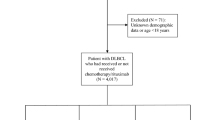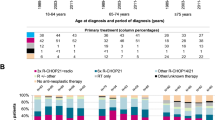Abstract
1–5% of cancer patients treated with cytotoxic chemotherapy die within a month after the administration of chemotherapy. Risk factors for these early deaths (ED) are not well known. The purpose of this study was to establish a risk model for ED after chemotherapy applicable to all tumour types. The model was delineated in a series of 1051 cancer patients receiving a first course of chemotherapy in the Department of Medicine of the Centre Léon Bérard (CLB) in 1996 (CLB-1996 cohort), and then validated in a series of patients treated in the same department in 1997 (CLB-1997), in a prospective cohort of patients with aggressive non-Hodgkin's lymphoma (NHL) (CLB-NHL), and in a prospective cohort of patients with metastatic breast cancer (MBC series) receiving first-line chemotherapy. In the CLB-1996 series, 43 patients (4.1%) experienced early. In univariate analysis, age > 60, PS > 1, lymphocyte (ly) count ≤ 700 μl–1 immediately prior to chemotherapy (d1), d1-platelet count ≤ 150 Gl–1, and the type of chemotherapy were significantly correlated to the risk of early death (P ≤ 0.01). Using logistic regression, PS > 1 (hazard ratio 3.9 (95% Cl 2.0–7.5)) and d1-ly count ≤ 700 μl–1 (3.1 (95% Cl 1.6–5.8)) were identified as independent risk factors for ED. The calculated probability of ED was 20% (95% Cl 10–31) in patients with both risk factors, 6% (95% Cl 4–9) for patients with only 1 risk factor, and 1.7% (95% Cl 0.9–3) for patients with none of these 2 risk factors. In the CLB-97, CLB-NHL and MBC validation series, the observed incidences of early death in patients with both risk factors were 19%, 25% and 40% respectively and did not differ significantly from those calculated in the model. In conclusion, poor performance status and lymphopenia identify a subgroup of patients at high risk for early death after chemotherapy. © 2001 Cancer Research Campaign http://www.bjcancer.com
Similar content being viewed by others
Article PDF
Change history
16 November 2011
This paper was modified 12 months after initial publication to switch to Creative Commons licence terms, as noted at publication
References
Antman K, Crowley J, Balcerzak SP, Rivkin SE, Weiss GR, Elias A, Natale RB, Cooper RM, Barbolie B and Trump DL (1993) An intergroup phase III randomized study of doxorubicin and dacarbazine with or without ifosfamide and mesna in advanced soft tissue and bone sarcomas. J Clin Oncol 11: 1276–1285
Begaud B, Evreux JC, Jouglard J and Lagier G (1985) Unexpected or toxic drug reaction assessment (imputation). Actualization of the method used in France. Therapie 40: 115–122
Blay JY, Chauvin F, LeCesne A, Anglaret B, Bouhour D, Lasset C, Freyer G, Philip T and Biron P (1996) Early lymphopenia after cytotoxic chemotherapy as a risk factor for febrile neutropenia. J Clin Oncol 14: 636–639
Blay JY, Ray-Coquard I, Mermet J, Maugard-Louboutin C, Ravaud A, Malet M, Cany L, Salles B, Mayeur D, Boutan-Laroze A, Sevin D, Vuvan S, Peaud PY, Balzon JC, Capdeville D, Suchaud JP, Celerier D, Zouai M, Mongodin B, Caudry Y, Chevreau C, Biron P and LeCEsne A (1997) ELYPSE 1: a multicentric prospective study of prognostic factors for febrile neutropenia after cytotoxic chemotherapy in general and cancer hospitals. Proc Am Soc Clin Oncol 16: 56a, 1997 (Abstr)
Blay JY, LeCesne A, Mermet C, Maugard C, Ravaud A, Chevreau C, Sebban C, Guastalla J, Biron P and Ray-Coquard I (1998) A risk model for thrombocytopenia requiring platelet transfusion after cytotoxic chemotherapy. Blood 92: 405–410
Chauvin F, Magnet M, Lasset C, G Catimel G, Mayer M, Chevarier P, Jacquin JP, Peaud PY and Clavel M (1990) Prognostic factors in the response of a first line chemotherapy in advanced breast cancer. Bull Cancer 77: 941–947
Fisher IR, Gaynor ER, Dahlberg S, Oken MM, Grogan TM, Mize EM, Glick JH, Coltman CA and Miller TP (1993) Comparison of a standard regimen (CHOP) with three intensive chemotherapy regimens for advanced non-Hodgkin's lymphoma. N Engl J Med 328: 1002–1006
Gomez H, Hidalgo M, Casanova L, Colomer R, Kay Pen DL, Otero J, Rodriguez W, Carracedo C, Cortès-Funes H and Vallejos C (1998) Risk factors for treatment related death in elderly patients with aggressive non-Hodgkin's lymphoma: results of a multivariate analysis. J Clin Oncol 16: 2065–2069
Grant JP, Custer PB and Thurlow J (1981) Current techniques of nutritional assessment. Surgical Clin North Am 61: 437–463
Hussain M, Kish JA, Crane L, Uwayda A, Cummings G, Ensley JF, Tapazoglou E and Al-Sarraf M (1991) The role of infection in the morbidity and mortality of patients with head and neck cancer undergoing multimodality therapy. Cancer 67: 716–721
Kimmick GG, Fleming R, Muss HB and Balducci L (1997) Cancer chemotherapy in older adults. A tolerability perspective. Drugs Aging 10: 34–49
Komaki R, Pajak TF, Byhardt RW, Komaki R, Pajak TF, Byhardt RW, Emami B, Asbell SO, Roach M 3rd, Pedersen JE, Curran WJ Jr, Lattin P and Russell AH (1993) Analysis of early and late deaths on RTOG non-small-cell carcinoma of the lung trials: comparison with CALBGB 8433. Lung cancer 10: 189–197
Kramer MS, Leventhal JM, Hutchinson TA and Feinstein AR (1979) An algorithm for the operational assessment of adverse drug reaction. I. Background, description, and instruction for use. JAMA 242: 623–632
Lilenbaum RC, Langenberg P and Dickersin K (1998) Single agent versus combination chemotherapy in patients with advanced non small cell lung cancer. Cancer 82: 116–126
Marks PN (1977) Nutrition and the cancer problem. Curr Concepts Nutr 6: 7–13
Morittu L, Earl HM, Souhami RL, Ash CM, Tobias JS, Geddes DM, Harper PG and Spiro SG (1989) Patients at high risk of chemotherapy-associated toxicity in small-cell lung cancer. Br J Cancer 59: 801–805
Radford JA, Ryder WDJ, Dodwell D, Anderson H and Tatcher N (1993) Predicting septic complications of chemotherapy: an analysis of 382 patients treated for small cell lung cancer without dose reduction after major sepsis. Eur J Cancer 29: 81–86
Ray-Coquard I, Le Cesne A, Rubio MT, Mermet J, Maugard C, Ravaud A, Chevreau C, Sebban C, Bachelot T, Biron P and Blay JY (1999) A risk model for severe anemia requiring red blood cell transfusion after cytotoxic conventional chemotherapy regimens. J Clin Oncol 17: 2840–2846
Restifo NP (2000) Not so Fas: Re-evaluating the mechanisms of immune privilege and tumor escape. Nat Med 6: 493–495
Riesco A (1970) Five-year cancer cure: relation to total amount of peripheral lymphocytes and neutrophils. Cancer 25: 135–140
Saito T, Dworacki G, Gooding W, Lotze MT and Whiteside TL (2000) Spontaneous apoptosis of CD8+ T lymphocytes in peripheral blood of patients with advanced melanoma. Clin Cancer Res 6: 1351–1364
Sculier JP, Weerts D and Klastersky J (1984) Causes of deaths in febrile granulocytopenic cancer patients receiving empiric antibody therapy. Eur J Cancer Clin Oncol 20: 55–60
Shipp MA et al (1993) For the international Non-Hodgkin's lymphoma prognostic factors project. A predictive model for aggressive non-Hodgkin's lymphoma. N Engl J Med 329: 987–994
Strand S, Hofmann WJ, Hugh H, Muller M, Otto G, Strand D, Mariani SM, Stremmel W, Krammer PH and Galle PR (1996) Lymphocyte apoptosis induced by CD95 (APO-1/Fas) ligand expressing tumor cells-a mechanism of immune evasion. Nat Med 2: 1361–1366
Tanaka M, Suda T, Hasa K, Nakamura N, Sato K, Kimura F, Motoyoshi K, Mizuki M, Tagawa S, Ohga S, Hatake K, Drummond AH and Nagata S (1996) Fas ligand in human serum. Nat Med 2: 317–322
Voorzanger N, Touitou R, Garcia E, Delecluse HJ, Rousset F, Joab I, Favrot MC and Blay JY (1996) Interleukin (IL-) 10 and IL-6 are produced in vivo by non Hodgkin's lymphoma cells and act as cooperative growth factors. Cancer Res 56: 5499–5505
Author information
Authors and Affiliations
Rights and permissions
From twelve months after its original publication, this work is licensed under the Creative Commons Attribution-NonCommercial-Share Alike 3.0 Unported License. To view a copy of this license, visit http://creativecommons.org/licenses/by-nc-sa/3.0/
About this article
Cite this article
Ray-Coquard, I., Ghesquière, H., Bachelot, T. et al. Identification of patients at risk for early death after conventional chemotherapy in solid tumours and lymphomas. Br J Cancer 85, 816–822 (2001). https://doi.org/10.1054/bjoc.2001.2011
Received:
Revised:
Accepted:
Published:
Issue date:
DOI: https://doi.org/10.1054/bjoc.2001.2011
Keywords
This article is cited by
-
Mortality of patients with solid and haematological cancers presenting with symptoms of COVID-19 with vs without detectable SARS-COV-2: a French nationwide prospective cohort study
British Journal of Cancer (2021)
-
Lymphopenia in Cancer Patients and its Effects on Response to Immunotherapy: an opportunity for combination with Cytokines?
Journal for ImmunoTherapy of Cancer (2019)
-
The impact of the preoperative peripheral lymphocyte count and lymphocyte percentage in patients with colorectal cancer
Surgery Today (2017)
-
Simultaneous detection of circulating immunological parameters and tumor biomarkers in early stage breast cancer patients during adjuvant chemotherapy
Cellular Oncology (2016)
-
Impact of venous thromboembolism on survival in patients with advanced cancer: an unmet clinical need
Internal and Emergency Medicine (2014)



